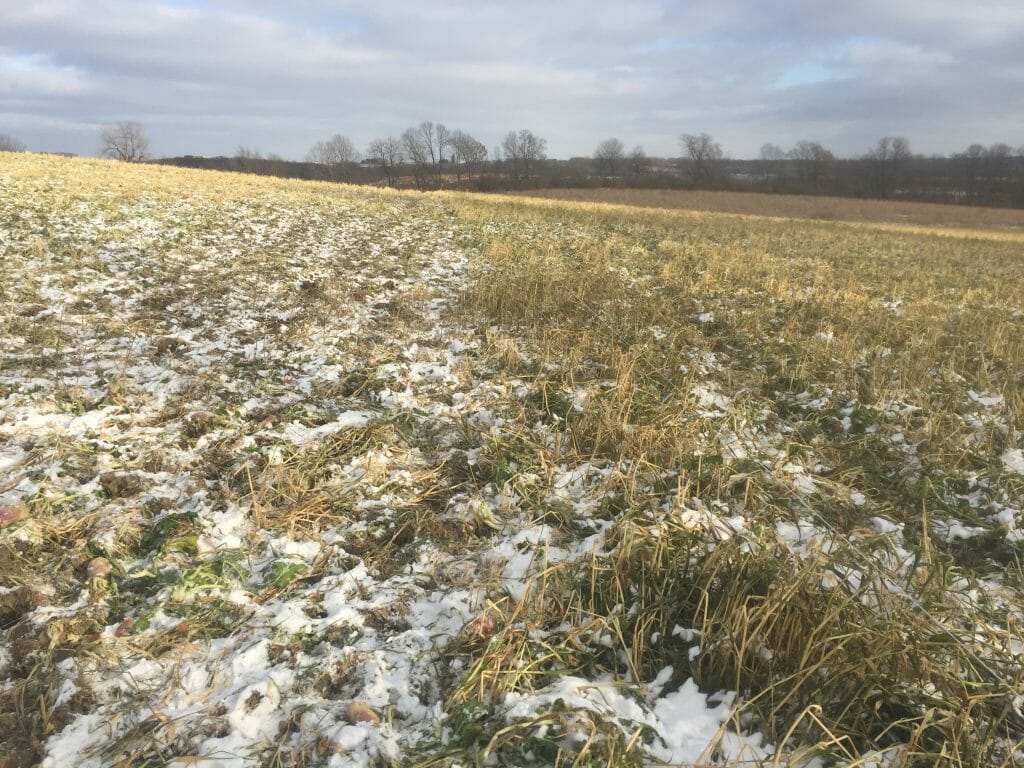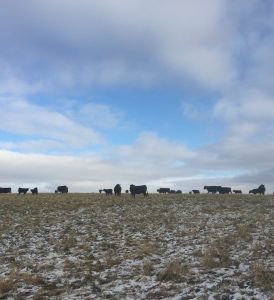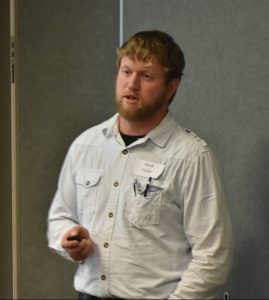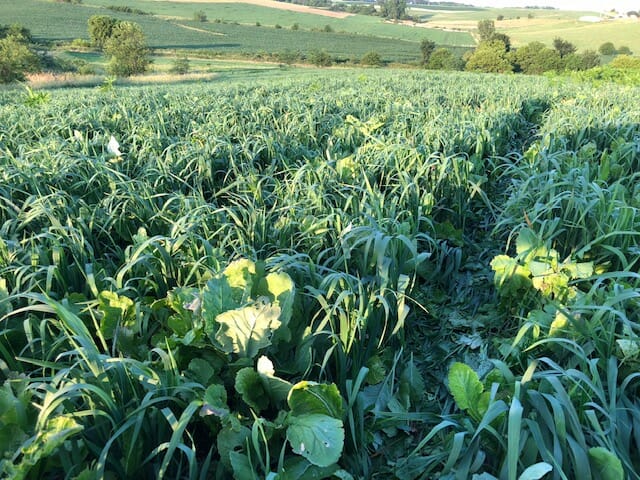Annual Forages Contribute to Year-Round Grazing
Farmers incorporate annual forages into crop rotations to complement perennial pastures
Think of winter and summer annuals as links in your forage chain. These forages can be used to diversify crop rotations and provide a foundation for livestock integration into your crop fields – while putting gain on animals at a time when perennial pastures need rest.
Diversifying Rotations
“My main purpose [for planting annuals] is to find a way to do what I love, which is livestock farming. My goal to bring grazing into my family’s row crop rotation,” says Luke Wilson who farms near Prairie City in Jasper County. Luke incorporates a full year of annual forages every third or fifth year in his family’s corn and soybean rotation – in order to graze cattle. Luke, who is active in Iowa Forage and Grasslands Council (IFGC), hosted a bus tour in November 2018 as part of the IFGC conference. Attendees witnessed cattle grazing stockpiled oats and turnips.

Luke Wilson uses single-strand wires to divide his annual forages into strips his cattle can rotationally graze. The wire can be seen in the bottom-right corner.
Luke’s acres are located on marginal, sloping ground near Lake Red Rock, where he has witnessed a positive response from planting diverse annual forages and integrating livestock. The annuals are grazed by heifers or cow-calf pairs, which are purchased or home-raised and developed on forage with a total mixed ration. Cattle are then sold as bred heifers through the Knoxville Regional Livestock Market weighing 1150 to 1300 pounds.

Luke Wilson’s cattle strip-graze stockpiled oats and turnips on Nov. 26, 2018. (Middle): Mark Yoder discussed research he conducted on grazing annuals during PFI’s 2018 Cooperators’ Meeting in December.
His preferred mix of forage annuals consists of Green Spirit Italian ryegrass, forage oats and brassicas. The brassicas are hybrid varieties that put on less bulb and more leaf and provide multiple grazings. The mix is no-till drilled in late March or April at a rate of 25 pounds per acre and costs $1.40 per pound; totaling $35 per acre in seed costs.
The oats come on first, ready to graze sixty days after planting. The Italian ryegrass fills in, providing high-quality grazing throughout the late spring and fall. The brassicas provide the majority of forage production during the summer. After dining on oat stubble, Luke’s herd continues to graze on ryegrass and brassicas until October or November. Italian ryegrass winter kills much of the time, but with adequate snow cover it will come up in the spring, providing another grazing or harvest opportunity before termination prior to corn planting.
Luke provides 40 units of nitrogen at planting, then again in June and August. In June, nitrogen “helps feed brassicas and rye after the oats have shut down, since they consumed the majority of initial nitrogen applied at planting,” explains Luke. “The most important nitrogen application is in August when the nights start cooling off. This helps boost forage production in the fall but also helps root systems develop to improve durability and winter survivability.” He has applied nitrogen in many forms – commercial, ammonia sulfate, urea, biosolids and chicken litter.
Mitigating the Summer Slump

Mark Yoder discussed research he conducted on grazing annuals during PFI’s 2018 Cooperators’ Meeting in December.
On May 31 of last year, Mark Yoder of Leon, planted 48 acres of summer annuals instead of soybeans in an effort to provide his cow-calf pairs forage during the “summer slump” – when cool-season perennial pasture growth slows during hot weather. The annuals were no-tilled into a field that had previously been growing a cereal rye and wheat cover crop. Mark’s 23-way mix from Green Cover Seed cost $33.00 per acre and Mark learned, “23 species is way too many. If we would have had fewer species, the sorghum and millet would have been thicker, especially for the second grazing in September.”
Due to complimentary growing patterns, when perennials needs rest, annuals are ready to graze and vice versa. Annuals help fill in forage gaps in grazing systems. Mark’s cattle grazed perennial pastures from June until late July, then were turned into the annuals. “When other people were running out of pasture, we had cows in the field eating forage that was eight feet tall,” commented Mark, allowing his droughty pastures to rest at a critical time. The Yoder’s were also able to make an extra cutting of hay from rested pasture. This also provides an opportunity to stockpile perennials, such as fescue, for winter grazing.
Fifty pounds of nitrogen and 20 pounds of sulfur were spread on the annuals on June 29, but Mark wishes he would have applied it earlier to boost grazing potential. Sixty cow-calf pairs got a total of 45 grazing days out of this mix, grazing from July 20 to August 19 and then again from September 19 until October 4. No supplemental feed was needed during these grazing periods.
“When other people were running out of pasture, we had cows in the field eating forage that was 8 feet tall.” – Mark Yoder
The 48 acres of annuals were split into 10 paddocks with single-strand electric fence. Mark spend 15 minutes every three days rotating the herd to the next paddock. A fenced-in alley allowed cattle to access water from a nearby pond.
Strip Graze if Possible
Strip grazing is recommended in order best utilize annuals. “Annuals will bounce back and grow rapidly if you’re diligent about strip grazing,” says Luke. It comes down to time and water; it’s labor intensive and might not be economical for everyone. Also, livestock must have water access from each strip, which can become an issue. Luke has different gates opening into a timber pasture where water is located, and cattle can always get back to that watering point.
Every couple of weeks Luke rotates his herd from annuals to perennials and back again. “This year I was shorter on time, so I grazed cattle on 50 acres of annuals for two weeks, then rotated them with three perennial paddocks. I know when I let them continuous graze for a week or longer I am giving up some production.” Luke doesn’t recommend turning cattle out on annuals for months at a time because this can cause damage to plants by selective grazing.
“My main purpose [for planting annuals] is to find a way to do what I love, which is livestock farming. My goal is to bring grazing into my crop rotation.” – Luke Wilson
Winter Annuals
Thinking ahead to next fall, a sequence of winter annual small-grain species can be seeded to provide forage over winter and early spring. According to Dr. Anibal Pordomingo, an animal scientist from Argentina, the potential for animal growth on winter annuals exceeds any other forage resource during that time period and can provide gains of 1.8 pounds per day in finishing steers. This gain is less costly than if feeding hay or silage. Cereal rye, barley, wheat, triticale and annual ryegrass are all viable winter forage options.
Mellow Soil
One of the benefits Luke sees to diversifying corn and bean rotations with forage annuals is the improved texture of the soil. “The next spring, we have the most mellow soil, and are able to no-till corn right into it. It works out so beautifully – the soil is stable from root mass but you can also pick up and it will crumble in your hand. That’s what we strive for and it doesn’t take machinery to get it, just plants and livestock.”
Luke has been able to find a way to keep doing what he enjoys while breaking the mold in Iowa. “It’s easy to feel as though you have to raise corn or soybeans, but there are so many forage species you can use and if you already have livestock, you’re going to find a way to be successful while thinking outside the box.” With the use of annual forages, it’s exciting to envision a forage chain that provides season-long grazing opportunities – while diversifying the landscape and benefitting the soil.

